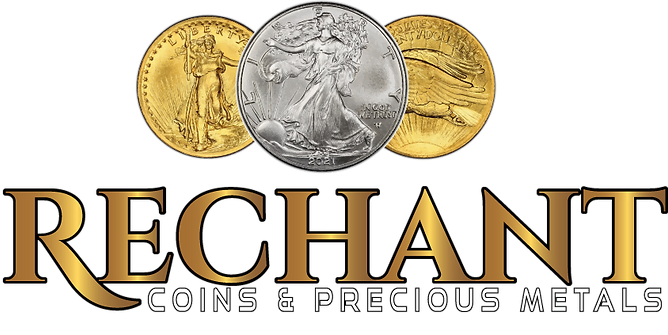Gold Bullion Vs Coins Value Clash
Gold bullion and gold coins offer us unique avenues for building wealth and securing financial stability. Deciding between these two involves considering factors like market liquidity, storage solutions, and resale potential.
As experienced coin dealers in South Florida since 1975, we at Rechant Coins & Precious Metals guide investors through these dynamic options.
From helping you understand intrinsic value to weigh costs, we’ve built decades of trust by providing competitive rates for bullion bars, collectible coins, and expert appraisals.
Read on to explore how gold bars and gold coins compare and discover your best investment path.
Click here to learn more about: for sale now
Gold Bars Vs Gold Coins
Gold bars and gold coins each bring distinct benefits as investment options. For large-scale investments in physical gold, gold bars—whether it's a kilo gold bar or 100g gold bars—are often the cost-efficient choice.
These bars may have a slightly lower price per ounce compared to coins due to their simplified production techniques at Mints (facilities). If your goal is to invest in gold bullion for long-term wealth storage, bars could align well with your portfolio (finance) goals.
On the other hand, gold coins often offer greater flexibility due to their smaller denominations and historical appeal.
Coins such as the Krugerrand or American Gold Eagle are popular not just for their weight but also for their collectibility and liquidity.
Coins are easy to trade or sell, providing options for investors who might need quick access to cash.
Rare coins like the Double Eagle also attract numismatic interest, adding another layer of intrinsic value. For new collectors, choosing coins over bullion bars can be a practical way to diversify (finance) wealth.
“Your decision to invest in gold bars or coins depends on your financial interest, storage considerations, and the level of market value liquidity you desire. ”
Storage and Portability Considerations
- Gold bars may require secure storage solutions like private vaults due to their larger sizes and weight. Larger gold bars attract serious investors but can be challenging to transport.
- Gold coins are often easier to store and trade, offering portability and convenience, especially for those interested in smaller bars or coins.
When you buy gold coins as part of your physical gold investment, you also gain easier resale prospects. Bullion coins like the Canadian Maple or Proof coinage in limited mintage can have higher market liquidity, making them an excellent addition to your investment strategy.
Whether you prefer bullion coins or gold bars, our expertise ensures that your investment aligns with your wealth and risk diversification goals. Visit Rechant Coins & Precious Metals in West Palm Beach for trusted advice on gold investment, including rare coins, bullion bars, and more.
Your Essential Guide to Bullion Coins and Gold Investments
If you’ve ever wondered why bullion coins are a cornerstone of both investment portfolios and collector sets, this is the guide for you. Gold bullion coins bring together the inherent stability of precious metals with striking designs that appeal to numismatists and investors alike.
This comprehensive guide will detail what makes bullion coins unique, explore their role in investments, and break down the financial advantages of adding gold to your portfolio.
Whether you're seeking a hedge against inflation or interested in diversifying your wealth, you'll find actionable insights here.
Bullion Coins: A Blend of Value and Craftsmanship
Bullion coins, unlike standard collectibles, derive their worth primarily from their precious metal content.
These coins are typically composed of pure gold, silver, or other precious metals, often with a fineness of 92% or higher. This distinguishes them from numismatic coins, whose value is influenced by rarity, age, or historical significance.
Popular examples include:
- American Gold Eagle and Gold Buffalo
- Canadian Gold Maple Leaf
- South African Gold Krugerrand
- UK Gold Britannia
These gold coins may also feature intricate designs, making them desirable beyond their gold content. Mints such as the U. S. Mint guarantee authenticity, adding to their appeal among investors and collectors.
Compared to larger gold bars, bullion coins offer greater flexibility for resale. Their standardized weights, like the one-ounce Krugerrand, ensure transparency in pricing, which is typically tied to the market value of gold. Whether you’re buying these coins for investment goals or simply as collectibles, they represent a practical way to own physical gold.
Bullion coins represent even greater flexibility compared to larger gold bars, making them a preferred option for smaller investments.
Bullion coins are also highly liquid, meaning investors can sell part of their portfolio with minimal effort. For collectors, the artistry and symbolism behind coins like the Double Eagle or modern proof coinage add an entirely different layer of value.
Benefits of Investing in Gold
Adding gold to your portfolio is one of the most reliable investment strategies available. Gold historically serves as a hedge against inflation and currency devaluation, preserving wealth over time. Whether you're comparing the price of gold bars to bullion coins, here’s why gold and silver investments are considered indispensable:
- Wealth preservation: Gold maintains its intrinsic value amidst economic uncertainty, providing unmatched stability compared to fiat currencies like the United States dollar.
- Market liquidity: Coins like the American Gold Eagle are widely recognized, offering easy conversion to cash.
- Diversification: Gold minimizes investment risk, acting as a counterbalance to market volatility.
- Tax advantages: In some regions, investments in precious metals may have favorable taxation policies.
Gold as an investment doesn’t just hedge against inflation; it also serves as a safeguard during geopolitical crises. The portability of smaller bars or coins makes them accessible to investors with varying financial goals.
If maximizing the value of gold appeals to you, consider options like bullion coins over larger gold bars. Coins are often issued with proof designs, appealing to both numismatists and those seeking financial stability. The ability to buy or sell them quickly ensures they remain one of the most liquid investments you can make.
Gold bullion coins, such as the Canadian Gold Maple Leaf, often blend beauty with utility, making them a timeless addition to any portfolio.
When deciding whether to buy gold bars or coins, consider your investment goals. Coins represent even greater flexibility and are available in smaller denominations. Investors aiming for long-term stability often find that gold coins offer the ideal balance of size, liquidity, and aesthetic appeal.
Key Insights on Bullion Coins and Gold Investments
- Bullion coins are valued for their precious metal content, often with a fineness of 92% or higher.
- Popular examples include the American Gold Eagle, Canadian Gold Maple Leaf, and South African Gold Krugerrand.
- Gold serves as a hedge against inflation and currency devaluation, preserving wealth over time.
- Bullion coins offer greater flexibility and liquidity compared to larger gold bars, making them ideal for smaller investments.
The Investment Dilemma: Why Gold Bars and Coins Matter
When considering gold as an investment, the decision between gold bars and gold coins is pivotal for both new and experienced investors. Your specific investment goals, available budget, and desired flexibility significantly influence this choice.
Below, we will explore the nuanced factors when choosing between bars and coins and understand how market liquidity shapes your strategy.
Whether you're looking for long-term wealth preservation or ease of selling during emergencies, this guide offers practical insights to maximize the value of gold in your portfolio.
Choosing Between Bars and Coins
For any gold investor, whether to buy gold bars or coins is one of the first decisions.
While both options represent excellent ways to own physical gold, the right choice heavily depends on your priorities and preferences. Let’s break down the factors that can help you decide more effectively.
Cost Efficiency and Intrinsic Value
Gold bars are often chosen by those prioritizing cost efficiency.
Due to their lower premiums over the spot price of gold, especially in larger sizes like the 1-kilo bar, gold bars are ideal for high-volume investors. This makes them a practical option for anyone focusing on acquiring maximum gold content at the lowest cost.
The trade-off lies in reduced flexibility when reselling smaller amounts.
Gold coins, such as the American Gold Eagle or South African Krugerrand, offer collectors and investors a different kind of value.
Beyond their intrinsic gold content, many coins offer numismatic appeal due to rarity, minting details, or historical significance.
While typically carrying higher premiums than bars, coins can act as both an investment and a hedge against inflation.
Flexibility and Liquidity
For those with shorter investment timeframes, gold coins may be the superior choice. Their smaller denominations enable quick transactions and provide more flexibility for partial liquidations.
For instance, selling an ounce of gold as 1-ounce coins is far simpler in most markets compared to dividing a large gold bar.
Conversely, long-term buyers focused on wealth preservation might prefer larger bars. These are easier to store and usually attract lower storage fees due to their compact nature.
During emergencies, smaller bars or fractional coins could prove more practical.
When deciding between bars and coins, align your choice with your specific investment goals, risk tolerance, and the type of gold bullion that best suits your needs.
The Role of Market Liquidity
How quickly and efficiently you can convert your physical gold into cash is dictated by market liquidity.
This aspect is central to developing a robust and responsive investment strategy, especially in volatile markets.
Understanding Liquid Assets
Bullion coins like the Canadian Gold Maple Leaf or American Gold Eagle are considered highly liquid assets.
Their standardized weight, widespread recognition, and consistent demand across global markets make them easy to trade. For investors in areas like Palm Beach or Fort Lauderdale, these coins represent a reliable choice for maintaining liquidity.
Gold bars, while valuable, can face liquidity constraints.
For example, a kilo bar may require a specialized buyer or dealer due to its higher cost and larger size. This can delay sales or complicate transactions, particularly during periods of rapid price fluctuation.
Practical Tips for Maintaining Liquidity
- Maintain a mix of assets, such as smaller gold coins alongside larger bars, to enhance portfolio flexibility.
- Engage with reputable dealers like Rechant Coins & Precious Metals, who offer competitive rates and easy transactions.
- Regularly appraise your gold holdings to stay updated on market value and identify opportunities for selling or buying.
By balancing liquidity and long-term growth objectives, investors can maximize the value of their gold holdings over time. Building relationships with trusted local dealers also ensures smooth transitions between buying and selling, especially in emergencies.
Key Insights on Gold Investment
- Gold bars are cost-efficient for high-volume investors due to lower premiums over the spot price.
- Gold coins, such as the American Gold Eagle, offer flexibility and numismatic value for collectors and short-term investors.
- Market liquidity is higher for bullion coins due to their standardized weight and global demand.
- Maintaining a mix of smaller coins and larger bars enhances portfolio flexibility and liquidity.
Unlocking the Value of Gold: Key Insights for Collectors and Investors
Gold stands as a timeless asset, cherished by both novice collectors and seasoned numismatists. Its allure lies not only in its aesthetic appeal but also in its financial stability, particularly during economic uncertainty.
This section explores the fundamental factors influencing gold value and breaks down the comparison between intrinsic value and cost, ensuring you understand the nuances of investing in gold bullion, coins, and bars.
Whether you're considering buying a Krugerrand, weighing options between gold bars and coins, or safeguarding wealth through precious metal diversification, the following insights will provide valuable guidance.
Let's delve deeper into the forces shaping gold investment and the strategies that can help maximize your portfolio's returns.
Factors Influencing Gold Value
Gold, as a financial asset and a collector's item, draws its value from multiple interconnected factors. One of the most significant drivers is global market demand.
Historically, a surge in interest for
bullion coins such as the
Gold Eagle or
Krugerrand often occurs during periods of economic instability. This demand underscores the nature of
gold as a resilient investment.
Geopolitical developments, including conflicts and global tensions, frequently elevate gold's position as a safe haven asset, boosting its market value.
For instance, during times of financial upheaval or uncertainty, investors often turn to gold bullion and coins like the South African Krugerrand to safeguard their assets.
Inflation and currency fluctuations also play a vital role in shaping gold's price.
When the United States dollar loses value, gold becomes an attractive hedge against inflation, prompting collectors and investors to buy gold coins or gold bars.
Even slight shifts in currency value can affect the overall price of gold, particularly for those diversifying their portfolios in physical gold.
Additional nuances, including the rarity and condition of coins, contribute to their specific value.
For instance, a gold Double Eagle from the early 20th century may command a higher premium than a standard gold bullion coin. Overall, understanding these factors allows collectors and investors to navigate the evolving landscape of gold investment effectively.
Comparing Intrinsic Value and Cost
The value of a gold coin or bar often extends beyond its mere metal content.
Intrinsic value, which reflects the raw worth of the gold's weight and fineness, forms the foundation for pricing. Additional expenses such as dealer premiums and production costs can significantly influence purchase decisions.
For instance, bullion coins like the
Gold Buffalo typically include premiums due to their intricate designs and minting quality.
While the intrinsic value remains constant, external costs such as transportation, storage fees, and taxes often add to the final price of physical gold.
Buyers of gold bars or coins should consider these elements when evaluating their overall investment strategy.
For those new to gold investment, it's essential to understand the distinction between intrinsic value and market premiums.
For example, bullion bars may offer lower premiums compared to gold coins, making them an efficient way to invest in gold.
On the other hand, coins often carry collectible value, attracting numismatists with their historical significance and limited production runs.
When selecting between gold bars and coins, factor in your investment goals. Smaller bars or coins offer greater liquidity, making them ideal for those who may need to sell part of their investment over time.
Meanwhile, larger bars often feature lower premiums by weight, appealing to investors focusing on bulk purchases. Whether you're assessing a Krugerrand, a 100g gold bar, or bullion coins, balancing intrinsic value with costs ensures a sound financial decision.
| Gold Investment Options | Key Considerations |
|---|---|
| Gold Bars | Lower premiums by weight, suitable for bulk purchases |
| Gold Coins | Higher premiums due to collectible value and intricate designs |
| Krugerrand | Popular choice during economic instability |
| Gold Double Eagle | Higher premiums due to rarity and historical significance |
Enhance Your Portfolio with Precious Metals
Gold and silver have long been trusted assets for preserving wealth, but their importance in portfolio diversification is often underestimated. Whether you're an experienced collector or new to investing, incorporating physical assets like bullion coins and bars can provide unparalleled stability.
This article explores why precious metals, such as gold bullion and silver coins, should be an essential element in achieving financial security.
Let’s dive into how gold coins and silver bars offer unique value, hedge against market uncertainty, and elevate your investment strategy.
Diversifying With Precious Metals
Gold, silver, and other precious metals provide investors with a tangible way to protect their wealth while reducing exposure to market fluctuations.
Unlike stocks or bonds, physical gold coins and bullion exhibit a low correlation with traditional investments. This makes them a valuable hedge that enhances financial resilience.
Unique Benefits for Portfolio Diversification
- Hedging Against Economic Risks: Gold bullion and silver coins act as a safeguard during periods of inflation or currency devaluation. While the United States dollar may fluctuate, the intrinsic value of gold remains stable over time.
- Liquidity and Flexibility: Bullion coins like the South African Gold Krugerrand, American Gold Eagle, and Canadian Gold Maple offer market liquidity, making them easy to buy and sell as financial goals shift.
- Tangible Wealth: Gold bars or coins provide a physical asset that’s not reliant on digital systems or financial intermediaries, offering peace of mind in turbulent times.
Adding Precious Metals to Your Portfolio
When deciding to invest in gold or silver, options such as bullion bars, gold investment coins, or silver bullion coins offer flexibility to fit your financial goals. For example:
Buying smaller bars or fractional coins allows investors to adjust holdings incrementally, while larger gold bars or kilo gold bars suit individuals focused on long-term wealth storage.
Additionally, gold coins often include collectibility factors, such as rarity and historical significance, which can enhance their intrinsic value over time. From gold sovereigns to Double Eagles, these coins could diversify and enrich any portfolio.
Investors must consider factors like the purity of gold, weight, and overall market value when selecting between bullion bars and coins. By doing so, you ensure that your investment aligns with your financial objectives while maintaining its liquidity.
Practical Tips for Precious Metal Investors
Adding precious metals like gold coins to your portfolio is a straightforward process when approached with clear strategies. Whether you’re aiming to buy gold bullion coins for flexibility or invest in gold bars for stability, the right approach can maximize returns while minimizing associated risks.
Tips for Buying and Selling Gold
- Understand Fineness and Purity: Coins and bars often come with a specified level of fineness, such as 9% pure gold. Knowing this helps determine the gold content and expected value.
- Research the Mint and Origin: Institutions like the US Mint or Royal Canadian Mint guarantee quality and authenticity, ensuring investor confidence.
Precious Metals
- Gold and silver have a low correlation with traditional investments, making them effective for portfolio diversification.
- Gold bullion and silver coins act as a hedge against economic risks like inflation and currency devaluation.
- Bullion coins offer market liquidity, allowing for easy buying and selling as financial goals change.
- Gold bars and coins provide tangible wealth, independent of digital systems or financial intermediaries.










